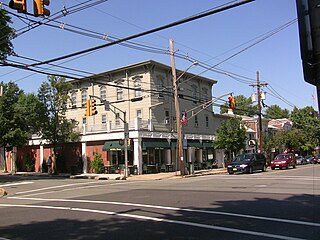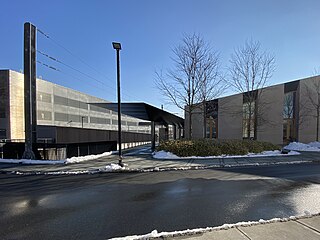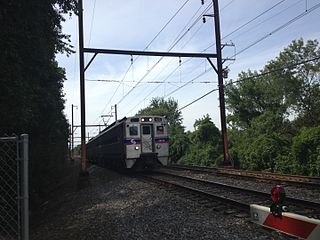
Hopewell is a borough in Mercer County, in the U.S. state of New Jersey. This historical settlement is located within the Raritan Valley region. As of the 2020 United States census, the borough's population was 1,918, a decrease of 4 (−0.2%) from the 2010 census count of 1,922, which in turn had reflected a decline of 113 (−5.6%) from the 2,035 counted in the 2000 census.

Pennington is a borough in Mercer County, in the U.S. state of New Jersey. The borough is located at the cross-roads between the Delaware Valley region to the southwest and the Raritan Valley region to the northeast. As of the 2020 United States census, the borough's population was 2,802, its highest decennial count ever and an increase of 217 (+8.4%) from the 2010 census count of 2,585, which in turn had reflected a decline of 111 (−4.1%) from the 2,696 counted in the 2000 census.

Yardley is a borough in Bucks County, Pennsylvania, United States. Yardley borders the Delaware River and Ewing, New Jersey to its east and Lower Makefield Township to its north, west, and south. The United States Post Office assigns many addresses in Lower Makefield Township the preferred city of "Yardley", although they are outside the borough. The population was 2,434 at the 2010 census. Yardley is part of the Delaware Valley metropolitan area.

The Mercer and Somerset Railway was a short-lived line of the Pennsylvania Railroad in western New Jersey, built to delay completion of the Delaware and Bound Brook Railroad, part of the National Railway line from Philadelphia, Pennsylvania to New York City.

Titusville is an unincorporated community and census-designated place (CDP) located within Hopewell Township in Mercer County, in the U.S. state of New Jersey. The area includes a post office with its own ZIP Code (08560), several restaurants, gas stations, a firehouse, and a small cluster of homes. The Washington Crossing State Park, dedicated to George Washington's crossing of the Delaware River in 1776, is adjacent to the community.

Princeton is the northern terminus of the Princeton Branch commuter rail service operated by NJ Transit (NJT), and is located on the Princeton University campus in Princeton, New Jersey. At the branch's southern end at Princeton Junction, connections are available to NJT's Northeast Corridor Line and peak-hour Amtrak trains. The shuttle train between the two stations is known as the "Dinky", and has also been known as the "PJ&B", for "Princeton Junction and Back". Now running 2.7 mi (4.3 km) along a single track, it is the shortest scheduled commuter rail line in the United States. Initial studies have been conducted to add a bus transitway along the Dinky right-of-way as part of a proposed bus rapid transit system.
The National Railway or National Air Line Railroad was a planned railroad between New York City and Washington, D.C. in the United States around 1870. Part of it was eventually built from New York to Philadelphia by the Delaware and Bound Brook Railroad and the Delaware River Branch of the North Pennsylvania Railroad, leased by the Philadelphia and Reading Railway, in 1879, and becoming its New York Branch. The line was intended to provide an alternate to the various monopolies that existed along the route, specifically the United New Jersey Railroad and Canal Companies and their Camden and Amboy Railroad, and as such had a long struggle to be built.
The North Pennsylvania Railroad was a railroad company which served Philadelphia, Montgomery County, Bucks County and Northampton County in Pennsylvania. It was formed in 1852, and began operation in 1855. The Philadelphia and Reading Railway, predecessor to the Reading Company, leased the North Pennsylvania in 1879. Its tracks were transferred to Conrail and the Southeastern Pennsylvania Transportation Authority (SEPTA) in 1976.

The Morrisville–Trenton Railroad Bridge is a rail bridge across the Delaware River between Morrisville, Pennsylvania and Trenton, Mercer County, New Jersey, United States.

Bound Brook is a New Jersey Transit railroad station on the Raritan Valley Line, in Bound Brook, New Jersey. The station building on the north side of the tracks is now a restaurant; the other station building on the south side is now privately owned. A pedestrian tunnel connects the south and north sides of the tracks.

Yardley station is a SEPTA Regional Rail station in Yardley, Pennsylvania. It is located at Main Street and Reading Avenue and serves the West Trenton Line to New Jersey. The station has off-street parking. In FY 2017, Yardley station had a weekday average of 349 boardings and 328 alightings. By August 2015, as a result of the SEPTA and CSX separation between Woodbourne and West Trenton stations, the outbound platform was removed, and all SEPTA traffic was diverted onto the Inbound track. Currently, all SEPTA service between Yardley and West Trenton operates on the Inbound track only.

North Philadelphia station is an intercity rail and regional rail station on the Northeast Corridor, located on North Broad Street in the North Philadelphia neighborhood of Philadelphia, Pennsylvania, United States. The Southeastern Pennsylvania Transportation Authority's (SEPTA) Regional Rail Trenton Line and Chestnut Hill West Line account for most of the station's service. Four Amtrak trains – three southbound and one northbound – stop on weekdays only.
The West Trenton Line is a proposed NJ Transit (NJT) commuter rail service that would be operated mostly on the CSX Transportation Trenton Subdivision, connecting West Trenton Station in Ewing Township, New Jersey with Newark Penn Station in Newark, New Jersey. The route would connect with the Raritan Valley Line at Bridgewater and the SEPTA West Trenton Line at West Trenton. As of 2007, NJT's estimate of the cost of creating a passenger line to West Trenton was $219 million. The project is still on the books, but no funding for the proposal has been secured to this date.
The Philadelphia, Newtown and New York Railroad was a railroad in southeastern Pennsylvania that is now a part of the SEPTA commuter rail system as the Fox Chase Branch. Despite the name, it only ever extended between Philadelphia and Newtown, Pennsylvania.

The Crusader was a 5 car stainless steel streamlined express train that ran on a 90.3-mile (145.3 km) route from Philadelphia's Reading Terminal to Jersey City's Communipaw Terminal, with a ferry connection to Lower Manhattan at Liberty Street. The Reading Railroad provided this service in partnership with the Central Railroad of New Jersey (CNJ), in which it was the majority owner of capital stock. Trains including the Crusader ran on Reading Railroad tracks from Reading Terminal in Philadelphia to Bound Brook, NJ, where they continued on CNJ tracks to Communipaw Terminal in Jersey City. Passengers then left the train and walked aboard the ferry or boarded busses that loaded onto the ferry. Introduced in 1937, the Crusader service declined during the 1960s, and the name was ultimately dropped in 1981.

Hopewell station is located in Hopewell, Mercer County, New Jersey, United States. The station was built in 1876. The head house has been on the state and federal registers of historic places since 1984 and was originally listed as part of the Operating Passenger Railroad Stations Thematic Resource. New Jersey Transit has proposed reopening the station to railroad service as part of the West Trenton Line.

The West Trenton Line is a SEPTA Regional Rail service connecting Center City Philadelphia to the West Trenton section of Ewing Township, New Jersey. With around 12,000 riders every weekday, it is the third busiest line in the SEPTA Regional Rail network.
The Operating Passenger Railroad Stations Thematic Resource is a list of 53 New Jersey Transit stations in New Jersey entered into the New Jersey Register of Historic Places and National Register of Historic Places in 1984 for their architectural, historical, and cultural merit.

The New York Branch or the Bound Brook Route was a railway line in Pennsylvania and New Jersey. It was operated by the Reading Company and owned by two of its subsidiaries, the North Pennsylvania Railroad and the Delaware and Bound Brook Railroad. It formed part of the Reading's route from Philadelphia to New York City, used by the famed Crusader. The line was transferred to Conrail in 1976 and was split into the Neshaminy Line and Trenton Line. SEPTA continues to operate commuter trains to West Trenton as part of its West Trenton Line.

The Neshaminy Line is a railway line in the states of Pennsylvania and New Jersey. It runs 21.7 miles (34.9 km) from a junction with the SEPTA Main Line just north of Jenkintown–Wyncote to West Trenton, just across the Delaware River. It was originally built in 1876 as part of the much longer New York Branch, which continued north to Bound Brook, New Jersey. The electrified section between Jenkin and West Trenton was designated the Neshaminy Line and is now owned by SEPTA. It hosts the West Trenton Line commuter rail service. The freight-only Trenton Subdivision runs parallel between Neshaminy Falls and West Trenton.



















